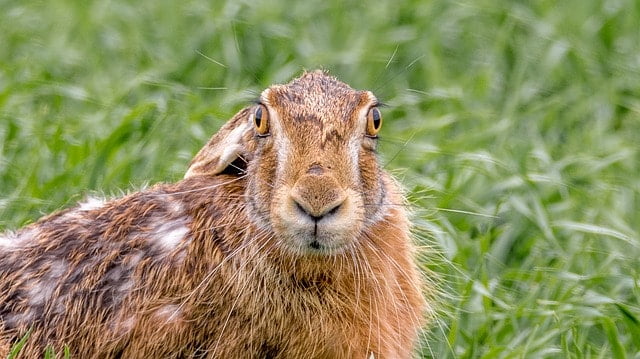Last Updated on March 2, 2023 by Marjon Ramos
Before I explain the steps of how to befriend a wild rabbit, I just want to offer some words of caution to anyone reading this.
While the idea of gaining the trust and affection of an animal from the wild seems like a great idea, you have to remember that wild animals have an instinct to fight whenever they feel threatened.
Be careful with wild rabbits because they can carry diseases and can fight back if they feel threatened by you.
Table of Contents
Steps on befriending a wild rabit.

There are two methods for befriending a wild rabbit.
The first one is to set a trap. While the other is waiting for it to come to you on their own.
I will mostly cover the second method, but the same steps can be applied if you’re planning on catching it first.
-
Don’t chase it!
The first thing you need to do is be very patient with wild rabbits.
Chasing it or showing them any threatening behavior will just make their instinct run into overdrive and drive them further away.
Instead of chasing the wild rabbit, lure it with food and wait for it to come to you. Rabbits are very curious creatures and like to inspect things they find interesting, as long as they feel like they’re safe. -
Provide some food.
Providing some food that rabbits naturally like can speed up the process of taming the wild rabbit.
The most common food to bribe wild rabbits is hay and veggies. You can also provide some sweet fruits, but make sure that you limit them because too many fruits can cause digestive distress to rabbits. -
Wait for the rabbit to come to you on their own.
After some time of feeding the wild rabbit regularly, hopefully, the wild rabbit now senses that you’re not a danger.
You can slowly show yourself to the wild rabbit, and if you are lucky, the rabbit might even come to you.
If not, repeat the process until they come to you. -
Try to slowly touch it.
For this step to work, you need to be able to get close to the rabbit without it running away.
Then, try to slowly place your hand near the rabbit and wait for them to smell your hand.
If the rabbit didn’t run away, then that’s your cue to slowly touch it.
If they do run away, be patient and keep repeating the steps until you gain their trust. -
Be patient.
Remember, rabbits are prey creatures. Every animal around them is trying to kill them.
So don’t be frustrated when, after a couple of tries, you still haven’t gained the rabbit’s trust.
Instead, think of it as a great achievement when the rabbit starts to trust you.
Challenges you might face when befriending a wild rabbit.
It would take a long time to befriend a wild rabbit.
Befriending a wild rabbit requires both patience and time. Wild rabbits, being surrounded by danger in all directions, develop a finely tuned instinct to be cautious about everything that moves.
And that includes us, humans.
Even if you provide them with food and shelter, there is no guarantee that you’ll gain their trust.
You might never befriend and gain the trust of a wild rabbit.
Every rabbit has a different personality. Some are more trusting than others.
That’s why, even if you do everything you can to befriend a wild rabbit, sometimes it’s just not going to happen.
You might luck out and find a more trusting wild rabbit. But don’t get your hopes up.
Wild rabbits might show aggression towards you for any reason.
As I mentioned, rabbits have an instinct to fight or flight (well, flight most of the time), so you have to be extremely careful that you don’t force the wild rabbit to use fight.
Holding or lifting up the wild rabbit can trigger the fight response and scratch and bite you. So, unless you’re 100% sure that you gained the rabbit’s trust, don’t ever lift it up or touch it.
Why should you befriend a wild rabbit?

If you manage to befriend one, wild rabbits can be a companion. Rabbits will require some time and attention, but the reward is worth it.
Rabbits are very social creatures once they trust you and will show affection to their owners just like any other pet.
Rabbits are also easy to care for; they require easily accessible food and they make no noise.
Why you should not befriend a wild rabbit

Wild rabbits can carry diseases.
If you have any other pets in your house, taming a wild rabbit might not be a great idea. Wild rabbits can carry diseases that they can pass on to other pets.
Wild rabbits can also carry ticks and fleas that can easily transfer to your other pets.
Wild rabbits are harder to care for as house pets.
If you think house rabbits are anxious and easily scared, multiply that by 3 and you get the anxiety level of wild rabbits.
Wild rabbits’ instincts make them harder to care for as house pets and they will likely exhibit wild behaviors even after having them for a long time.
Wild rabbits are aggressive.
Due to hormonal and instinctual reasons, wild rabbits are more aggressive than house rabbits.
You can try to lessen the aggressive behavior by getting the wild rabbit neutered. This would lessen the hormonally related aggression considerably.
Wild rabbits are not as affectionate as house rabbits.
Wild rabbits are not as affectionate as house rabbits because they will always have this uneasiness feeling around you, who they will always see as a potential threat, even after many years of you two being together.
Summary
You can befriend a rabbit by either trapping it first or luring it by providing it with food. You can lure wild rabbits with hay, veggies, and fruits.
After a while, with luck, the wild rabbit might get curious and come to you on their own. But if not, you have to wait for it to come to you on its own.
Never chase or show any aggressive behavior towards the wild rabbit.
If you’re able to get close to the wild rabbit without it running away, you can now try to touch it slowly. You do this by placing your hand near the wild rabbit and letting it smell you.
If the wild rabbit doesn’t run away after smelling your hand, it’s your cue to touch them. Never lift a wild rabbit because it could trigger a fight response and bite and scratch you.
Cite this article:
Related Articles
- Can Rabbits Eat Asparagus? 9 things you need to know.
- Can Rabbits Eat Tomatoes? What You Need To Know.
- Can Rabbits Eat Watermelon? What You Need To Know.
- Can Rabbits Eat Grapes? What You Need To Know.
- Can Rabbits Eat Broccoli? What You Need To Know.
- Can Rabbits Eat Apples? What You Need To Know.
- Can Rabbits Eat Cabbages? What You Need To Know.
- Can Rabbits Eat Strawberries? What You Need To Know.
- Can Rabbits Eat Bananas? What You Need To Know.
- Can Rabbits Eat Oranges? 9 things you need to know.
- Can Rabbits Eat Blueberries? Here’s Why.
- Can Rabbits Eat Spinach? Your Questions Answered.
- Can Rabbits Eat Cucumbers? Here’s Why.
- Can Rabbits Eat Celery? What you need to know.
- Can Rabbits Eat Radishes: Everything You Need To Know
Sources and further reading
- Buseth, Marit Emilie., and Richard A. Saunders. Rabbit Behaviour, Health, and Care. CABI, 2014.
- Lebas, F. The Rabbit: Husbandry, Health, and Production. Food and Agriculture Organization of the United Nations, 1997.
- Patry, Karen, et al. The Rabbit-Raising Problem Solver: Your Questions Answered about Housing, Feeding, Behavior, Health Care, Breeding, and Kindling. Storey Publishing, 2014.
- How to Tame a Wild Rabbit




